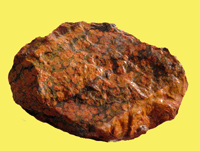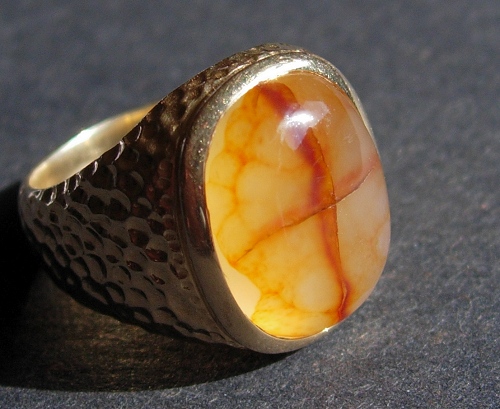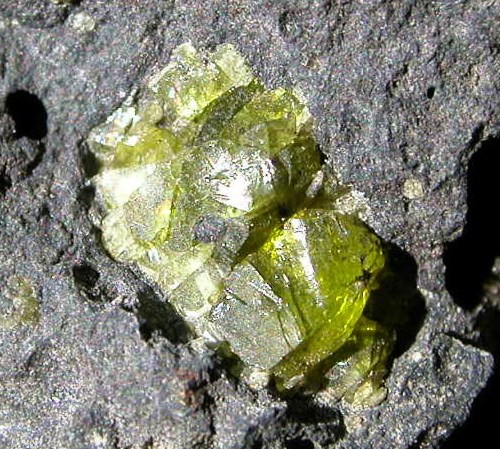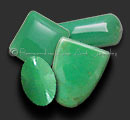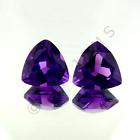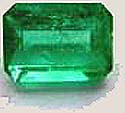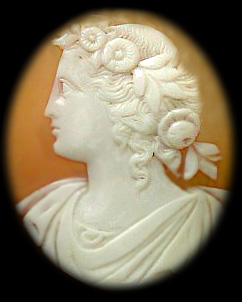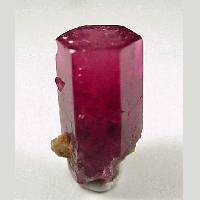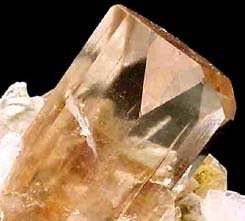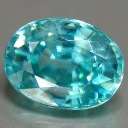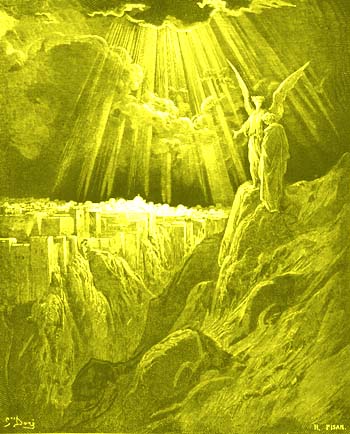
The
Bride in
All Her Glory
God told John at the beginning of the book of Revelation to record the things he would see and hear because the time was at hand. Obviously, God did not intend those words to mean that everything He prophesied about would happen immediately or come to pass in one fell swoop. Anyone who takes even a glance at Christ’s great prophetic dialogue known as the Olivet Discourse depicting the signs of His Return knows that the prophecies would extend over a wide range of time during this Age of Grace. What God was getting at was simply this: everything recorded in Revelation could be put to spiritual use by the believer right away, and could have impact on their life no matter where they lived in the time line of God’s extended time of salvation for the Gentiles. Everything in Revelation could be pertinent and would be beneficial to their understanding and applicable immediately to their faith. What that means is that all the things written in Revelation have been pertinent to the followers of Christ from day one. It has been God's hope that all Christians, from the first century A.D. on, would absorb the lessons of Revelation, heed its warnings and accept its charitable, loving admonitions and advice. If the time for its understanding and application was immediate, then so be it. If more pertinent to a succeeding generation then, let it be. Everything that was once pertinent certainly must be even more vital now as the day of Christ's appearing and His Second Coming draws nearer with each passing day. SEE our extensive WEBSITE SECTION to study – THE SIGNS OF JESUS’ RETURN
The vision of the Lamb’s bride in the second part of chapter twenty-one, which we are about to study, is no less important to our faith than any other part of Revelation. This panoramic picture is actually a detailed analysis of the Bride's character and must not be viewed superficially, merely as a passing portrait of an obscure subject of mere curiosity. She is beautiful, yes, but what her beauty symbolizes is what should penetrate into our faith, get hold of our heart and mind and serve us as a role model that our personal life should validate. In verses 9‑27 God has revealed to us a glorious Bride without spot or wrinkle. This is the Bride in all her holiness, goodness of character and faith. God has made this vision available to all Christians, down through the Church age so they could have something with which to compare themselves, a sort of mirror in which to adorn and prepare themselves so they would be ready for the appearance of the Bridegroom. This representation of the Bride, descending out of heaven to be merged with God as one forever, is a metaphor used by God to show us the spiritual requirements and condition of faith through the mysteries, parables, and exemplary lives of illustrious women who represent attributes and faith of Christ's eternal wife.
The first part of the second to last chapter of the bible introduces us to eternity, the promised utopic paradise of God. We are told how everything will become new. Nothing in the former world will be able to tempt us or overcome our hope, faith and love in God. We are put at ease, God will not permit fearful people, doubters, liars, haters or sinners of any sort to enter in to this realm which is the exclusive domicile of the Bride. Only the righteous in Christ will dwell as one with Him. The Father and The Son shall be its light and power source. There will be no moon, sun stars or such ‘artificial’ light. Perfect beings in a perfect setting secure for all eternity. God will be all in all. The Scriptures advance the thought in this way – everything is ours, we are Christ’s and Christ is God’s. We belong and everything belongs to us.
In the first part of the chapter we had been alerted to the vision of the Bride of Christ, that glorious body of faithful believers who have been taken into eternity to live with Christ: "And I John, saw the holy city, new Jerusalem, coming down from God out of heaven, prepared as a bride adorned for her husband." (Rev. 21.2) We recall the words of the Bible, the mystery of Christ and the Church, which is revealed in Ephesians declaring Christ's ultimate purpose for The Church, "That he might present it to himself a glorious church, not having spot, or wrinkle, or any such thing; but that it should be holy and without blemish." (Eph. 5.27) A few verses later we are directly and explicitly told by an angel that this city is a symbolic representation of the Bride, a visual aid of the mystery now complete and in full order, of Christ and His perfect Church, the Lamb’s wife descending from heaven, fitted out and fully suited as the eternal dwelling place of God.
"And there came unto me one of the seven angels which had the seven vials full of the seven last plagues, and talked with me, saying, Come hither, I will show thee the bride, the Lamb's wife." (Rev. 21.9)
Details of her beauty are about to be revealed in the powerful symbolism afforded by a rich and magnificent city. God reserves this epic depiction of her beauty for the second half of the penultimate chapter of the Bible. We are closing in on His final few words of Holy Writ. It is more than a fleeting glimpse into the eternal marriage of Christ and a spotless church, the vision being full of symbolic meaning. The Bride's importance in the grand scheme of redemption and into eternity should not escape the reader as it is exhibited by the fact that she, the glorious wife of Christ, is also the final major topic to be revealed in Holy Scripture. It can be said that God ends His revelation to mankind by showing him the Bride of Christ. Up to this point she has only been mentioned briefly, her reality alluded to by prophets Isaiah, Ezekiel, Jeremiah, Solomon and David, her future glory only hinted at, spoken of merely for the record and to give hope to those of us who accept what Abraham accepted, that we are strangers in a strange land, looking for an eternal home not made by hands, but by God, wherein righteousness dwells. It is worthy of note that the Bible begins with man alone in a garden. It ends with man in an enormously rich city in a vast social setting with countless friends and eternal relationships of undying love.
Now God is about to give the serious student of Scripture, those who have forged their way through Revelation, a series of snapshots within the overall picture of the Bride. Each one is a small picture within the big picture, each giving us deeper insight into her development, her holiness, her fidelity and her unimpeachable character of spirit. Each snippet should be scrutinized with the care which an art dealer inspects a master piece he is considering for purchase. Each picture detail of the Bride is worth examining with spiritual eyes seeking the mind of Christ for personal application. Each brush stroke of this picture of the Bride is worth analyzing so that we, the prospective Bride may peer at the handy work of Christ who is preparing the Bride so that he may present her to Himself holy and unblemished, a perfect piece of beauty artfully formed and lovely. We should use this picture to peer into our own heart, as a mirror, that we are prepared for His coming in hopes that He will find us to His liking, humbly waiting for His arrival among the others who have sought out eternal Brideship with God. Do we conform to her? Are we without spot or wrinkle or any such blemish, spiritually speaking? Are we doing the best we can to please Him by faith? God is giving us one last mirror in which to see our own reflection, to see if we are matching her beauty, in hopes that we will be found among her number. Verse nine offers the first clear picture where we can stop to rest and begin to compare ourselves to the bride-in-waiting.
It is not a coincidence that it is one of the judgment angels of the seven last plagues that introduces us to the Bride. To be counted among her number is a great judgment, though it is a good judgment, it is nonetheless a judgment, also for those who do not make the grade. To be excluded from her is a total spiritual disaster. In the preceding verse we learned who and what she will not be like. Those who couldn't find it in their heart to truly trust God are not part of the Bride. Those who were afraid and could not believe that all things work together for good to those who love God and are called according to His purpose will not be among the chosen ones as the Bride. There is no place for nay sayers or doubters in the eternal bosom of Christ? And, of course, those who hypocritically cling to their sins (not those who fall occasionally or sin unwillingly, but those who love sin, willingly sin, hate repentance and cling to unrighteousness and self), such as: idolatry, fornication, hatred, lying, stealing and any other thing that is opposed to the sound doctrine of the Bible will be cast into outer darkness. Christians who claim they are Christian, but really are not in word and deed will be exposed by the Truth. The Father will not give away a corrupt Bride to His Son. There is no place for duplicity in the Bride. She cannot have one foot in the world and one in Christ's bed. She cannot be kind or gentle, but still be whorish. She cannot be faithful and free of idolatry, but still lie in her heart. She cannot be reverent and obedient, but be a rebel or non-submissive to God’s will, or a hater or have murder in her heart. She must be without spot or wrinkle or any such blemish. Ninety percent good and ten percent bad is not good enough. We are not talking self-righteousness here. All the righteousness of the Bride will have been worked in her by Christ Himself by the ministry of the Holy Ghost. Those who walk in the Spirit they are the sons of God. See: Living and Walking in the Spirit. Above all she cannot be full of fears and doubts about God’s goodness or that He is in control of all things. She must be ‘perfect’ in these things, perfectly situated and settled and trusting in God’s perfection. Not perfect according to man’s ideas but according to the standards of God’s perfection. She will believe in the way that the Psalmist describes the desire for a perfect walk. “I will behave myself wisely in a perfect way. O when wilt thou come unto me? I will walk within my house with a perfect heart.” Psalms 101:2
It is a matter of having a perfect heart toward God. The philosopher David Hume defined perfection as: “That which is perfect is that which conforms to its standards.” When it comes to spiritual perfection in Christ it is god who sets the standards and not man or any sport of church doctrine. The standards of godly perfection for the Bride conform to the standards of God’s hope, faith and love and have been declared throughout the Scriptures in things regarding righteousness, walking in the Spirit, conforming to Christ and bringing all thoughts of our mind into the obedient captivity of Christ. His standard is holiness, as the bible says, “without which no man shall see God”. Holiness is being separated from ungodliness to godliness. Not that man can be perfect on his own account without the grace and help of Jesus Christ the Savior, but that we can be perfect in Christ by the requisites of faith. It is not that we will never stumble, it is only that when the weight and sin of this life and world beset us we seek Christ to shake them off our back for us. We do it His way and let the Holy Ghost guide us out of the dark and out of the ditch and into the light. The Bride sings in her heart with trust, along with David’s song of Thanksgiving: “God is my strength and power: and He makes my way perfect.” 2 Sam. 22:33 How else could the Old Testament and Jesus both say, (without laying a guilt trip on us) “Be perfect even as your Father which is in heaven is perfect.” Deut. 18:13 & Matt. 5:48 This is the perfection and spotless character of Christ’s wife. God gives her the power to walk in perfection. He does it by His magnificence, but she must allow Him. Do not buy the deadly doctrine that is foisted upon us by the ill-advised doctrines of fabulously popular Laodicean indifference a call to humility and perfection. There are a ton of things required of the Bride which we will seed pictured in the snap-shots of the verses we are about to inspect. She must dress in proper spiritual apparel. As the famous theologian Karl Barth noted, the commands in Scripture are issued in the form of imperatives rather than laws. For instance, we are directed to ‘put on’ certain things, the new man, righteousness, Christ, and so forth. This is something we have to learn how to do and make sure we keep doing it according to need. Just as we put on some proper article of clothing to suit a particular purpose or social occasion. It requires our action, our discretion, our obedience, just as when mom told us to put our coat on as we were going out the door in the dead of winter. We must be obedient to the imperatives issued the bride, they are those things imposed on us by the realities of the mysteries of the gospel. Accordingly, we must submit, concede, receive, walk, wait, humbly serve, separate ourselves, bring our thoughts into the obedience of the captivity of Christ – love Him, set our heart to be wedded to Him for eternity. These the bride must decide to do and then actually do them. God cannot and will not do them for us. The Bride has no other God than her Lord; hides no other God in her back pocket or purse while standing before the Father. She must be a dutiful wife, faithful wife, with all fidelity, she is a green virgin, she has faith and confidence in her husband precisely in the way that the virtuous woman of Proverbs 31 lives for her Lord’s glory and reputation and serves with joy. Otherwise, how could the marriage work? All the interactions and lessons of marriage in this life are nothing more than transitory images meant to show the eternally great spiritual truth that Christ is to be married to His beloved Church of the separated ones. Eph. 5.24‑32 If fornication and adultery are not permitted, are not accounted as righteousness in this life, should we think that God will permit them in the marriage of His Son?
His blood runs through her veins
"And he carried me away in the spirit to a great and high mountain, and showed me that great city, the holy Jerusalem, descending out of heaven from God, Having the glory of God: and her light was like unto a stone most precious, even like a jasper [red] stone, clear as crystal;" (Rev. 21.10‑11)
The angel at once carried John away to a high mountain to show Him the Bride. It must be that her beauty and enormous glory could only be seen from a great vista. When we look at the Bride we are looking at the domain of Christ; this is His kingdom to which there shall be no end. The mention of a mountain overlooking a kingdom transports us back to another time when another angel, a fallen one, took Jesus to a mountain to show Him the glories of this world and to tempt Him to give up His quest for a Bride and rather bow down to him. "The devil taketh him up into an exceeding high mountain, and showeth him all the kingdoms of the world, and the glory of them; And saith unto him, All these things will I give thee, if thou wilt fall down and worship me." Matt. 4.8‑9 Christ resisted the Devil and won the battle. Now Christ's faithfulness and truth has received its rich reward. We go to the top of the mountain to see the kingdom for which He awaited. The light emanating from the Bride pulsates with life. The jasper stone is clear as crystal, but has laser‑ like streaks of deep red light running throughout her. It is the cleansing, life giving blood of the Lamb. The blood of Christ runs through her veins, forever giving her strength and life. She is infused with the life of God. Every saint who is blessed to be part of the Bride is empowered with the authority and almighty unction of the blood of Christ their Savior. It is by the blood of Christ that she has utilized authority in His name and won victory over demons and devils that were at work to try to defile and subjugate her to sin. The blood of Christ has given her power to resist temptation, that blood which has purifying power as the initial remedial healing for what ails man’s dysfunctional soul. The blood of Jesus alone gives access to the throne room of God during these trials and toils of earthly life. It made it possible for the door of God’s correction and hope to swing open, so that God would hear prayers and cries for deliverance. This Jasper stone, with the blood-red vein of redemption running through is the symbol of her covered shortcomings and sins, and by the blood she won the forbearance of God and relied upon His living mercy in a merciless and cruel world. By it she is cleansed and made clean from past defilements. By the blood she defeats the enemy of their souls, and by it all perfection was initiated, and by it life was granted to her. Overcoming in Christ: They overcame him by the Blood of the Lamb
The jasper stone, in which the city is encased, is pure and perfectly transparent and clear, except for the streaks of deep red veins in her. She has nothing to hide, no hidden sin, no dishonest agenda, no subversive ideas, not even a flaw. She is redeemed. They are permanent reminders of the wonder‑working power of the Lamb's blood. No member of the Bride will be without this covering, or without the victories that the blood of Christ brings in this life, not least the perpetual covering of God’s love and grace. Because of the blood she will be able to love God for all eternity without reservation or restriction, in full assurance of faith because He wooed her and courted her and loved her first. How can she be casual or indifferent about this love? She loves Him the way the beloved loves her suitor in the Song of Solomon, with her whole heart, unrestricted.
She is perfectly secure; on a perfect foundation
"And she had a wall great and high, and had twelve gates, and at the gates twelve angels, and names written thereon, which are the names of the twelve tribes of the children of Israel: On the east three gates; on the north three gates; on the south three gates; and on the west three gates. And the wall of the city had twelve foundations, and in them the names of the twelve apostles of the Lamb." (Rev. 21.11‑13)
In verses 11-13 some of the details of the bride/habitation of God start to come clear to us. There is a high wall, twelve gates, and it rests on twelve foundations. It is immense. Our attention is captured by her twelve gates and twelve foundations. Each gate and foundation has a name written on it. We suddenly realize that the Bride is made up of both the children of Israel and the Church, represented in name by the twelve sons of Jacob and the twelve apostles of the Church. This is the fulfillment of the promise to Abraham which God made to him: “And in thy seed shall all the nations of the earth be blessed; because thou hast obeyed my voice.” Men and women of faith from every epoch of this age and every nation on earth make up the Bride and are now living under one banner, dwelling together with faithful Jews, together as “The Commonwealth of Israel”, as the bible puts it. Eph. 2:12 The Bride that exists in these last days is only different from those who have prepared themselves by holiness and purity in the fact that they are the last generation, the Bride making the final invitation to the world to spotless and virtuous walk worthy of the Bride of Christ. The way of being a part of the Bride was made possible by the twelve tribes of Jacob, who, for our sakes, were used as examples to show the Gentile world the truth about sin and the way of salvation. We remember that the letter to the Romans spoke to us about our being the "wild" olive tree grafted in at Israel's expense and that someday the Jews would be restored to God. In previous chapters of Revelation we see the 144,000 believers out of each tribe of Israel being sealed with the protection of God during the Tribulation, and we see the salvation of Jerusalem at Christ's return. Chapter 14 of Revelation showed us a group of 144,000 followers of the Lamb, redeemed from among all the peoples and nations of men living atop heavenly Mount Zion, indubitably a snap shot of instruction about the nature and character of the promises and the imperatives of spiritual conduct for the Bride itself. This scene of a ‘city’ or place of habitation for God, now coming down from heaven is the moment when the true "brotherhood of man" and the utopic union with God becomes established reality for all eternity.
The Church is fully represented as seen in the city's foundations which are named after the Lamb's closest friends and pillars of the Church. They are those who left everything behind; separated themselves for the gospel’s sake as Matthew did when he left the money changer’s table, as Andrew did when he left off following John the Baptist, as Nathanael did when left his cynical lounging spot beneath the fig tree, as Peter did when he put down his net and left his father's business, all of them to be followers of Jesus day and night no matter where he went. The Bride is all they who leave everything behind in favor of being the espoused husband of their Lord and Savior, Jesus Christ. These twelve apostles are general representatives, with their spirit of faith and loving trust in the Savior, with a common spiritual character which the Bride must and will have. Like the 12 apostles, she has left the world with its lures and cares behind, so she can be with Jesus. See: Separated
"And he that talked with me had a golden reed to measure the city, and the gates thereof, and the wall thereof. And the city lieth foursquare, and the length is as large as the breadth: and he measured the city with the reed, twelve thousand furlongs. The length and the breadth and the height of it are equal. And he measured the wall thereof, an hundred and forty and four cubits, according to the measure of a man, that is, of the angel. And the building of the wall of it was of jasper: and the city was pure gold, like unto clear glass." (Rev. 21.15‑18)
We are then shown the dimensions and magnificence of the Bride. These measurements, like all the other pictures, are symbolic. The Bride is not actually a city, that would be absurd, God’s purpose for creating Man and undertaking all the abuse and heartbreak involved in redeeming Man is not to acquire for Himself an inanimate city. The city we are shown merely personifies the living Bride. “Now therefore ye are no more strangers and foreigners, but fellow citizens with the saints, and of the household of God; And are built upon the foundation of the apostles and prophets, Jesus Christ himself being the chief corner stone; In whom all the building fitly framed together groweth unto an holy temple in the Lord: In whom ye also are builded together for an habitation of God through the Spirit.” Eph. 2:19-22
To understand the symbolism we must take into consideration what the city metaphor symbolizes in Scripture. Cities in Biblical days did not conjure up the same image in a believer's mind as they do in today’s America. Today we think of the city as a place of violence and decadent living. We think of poverty and drugs, confusion, pollution and turmoil, rundown buildings and methadone centers. There are threats on every side. But in the days of the Bible it was just the opposite. The city was a place of refuge. God tells the dispersed Jews of the Babylonian captivity to seek "the peace of the city". Under the law a person who accidentally killed someone could run to a specified city and be safe from retribution by one of the victim's family members. Cities were places of wealth and security. The walls provided the inhabitants within a haven from robbers and warring or marauding armies. When her gates were shut at night, sin and lawlessness was shut out. Inside her walls law and order prevailed and was strictly enforced. It was in the city that the authority of the king offered full protection and recourse under the law. Outside on the plains, the mountains or in the woods, man was on his own, left to fend for himself and defend himself against attack. Caravans laden with gold, spices, tapestries, camels and oxen, delicacies, tools, fuel and weapons, even books and styluses, streamed into every major city of the Middle East. It was in the city that commerce flourished and could be conducted without fear of being vandalized. The shops of craftsmen and skilled artisans in every trade were to be found lining the streets of her commercial districts. Wealth was concentrated in the cities. If riches and luxury was to be found in a nation or region, it was to be found in its cities. These are the first places that the Gospel was preached. Physicians and medical care could also be found in the city. Outside the city there was very few doctors and even less knowledge of medicine. All of man's physical needs were accommodated in the ancient city. The mind, too, was nurtured in the city. All libraries and seats of learning were situated behind the comfortable walls within the peaceful confines of city life. Schools of learning and education were the sole province of the metropolis. There, priests and scholars taught and instructed pilgrims who came for education and to worship their favorite god. The city did not only provide for the needs of the body and soul, it was also the center of worship for every nation. The temples and shrines were placed within the confines of a well guarded city. The king, often the high priest or center of worship, resided in a palace within the city. In short, living outside the city was risky. There were threats on every side, with no place to run and hide other than the city. Living inside the protective walls of a city provided every possible security of law and order while affording its inhabitants the chance to acquire wealth and to live in luxury. The city of the ancient world, therefore, is a fit symbol for the Bride of Christ. God has taken the measure of the city and it is a perfect cube 12,000 x 12,000 x 12,000 furlongs. (It is a 1,500 mile cube, or about the size of the United States.) It measures out a perfect multiple of twelve, the number of God's perfect government as illustrated by the twelve tribes of Israel and the twelve apostles. It could be argued that the twelve tribes are the Father’s representatives and the Apostle’s are the Son’s personal emissaries of orderly perfection. Her walls are also a perfect multiple of twelve measuring 144 cubits high. Within her walls is the perfect government and rule of community under God. (Thus the 144,000 Jews and the 144,000 followers of the Lamb are numbers representative of perfect government and order, perfect leadership of the Father and the Son together, within the habitation of the eternal Bride.) There is nothing like anarchy and no rebellion. Everything is in perfect harmony and is perfectly proportioned and perfectly led down to the slightest detail. All sin is shut out and nothing evil or threatening can enter through the gates and into the Bride(city) ever again. She will be a Mecca for each and every kind of unimaginable riches and beauty of spiritual things for all eternity. The Bride, being likened to a city, is a promise of all that is good and strong about a city. She is secure, rich, beautiful, learned, healthy and free to worship God in peace for all eternity. Reason enough to strive to be part of her
one should say.
We are to be God's Jewels
The prophet Malachi, prophesied of a day when God would gather together all those who love Him to make them into the jewels and centerpieces of a totally new and revamped universe. "Then they that feared the LORD spake often one to another: and the LORD hearkened, and heard it, and a book of remembrance was written before him for them that feared the LORD, and that thought upon his name. And they shall be mine, saith the LORD of hosts, in that day when I make up my jewels; and I will spare them, as a man spareth his own son that serveth him." Malachi 3.16‑17 We can only wonder at what this imagery means and how such splendor could possibly be displayed through the children of dust. Somehow, though, our time‑worn flesh will be turned into such stunning beauty that it will surpass the radiance of the sun, the magnificence of the moon, the brilliance of the stars, the majesty of any nebulae, red Mars, even the Aurora Borealis, or any resplendent thing that this present universe has ever known. God will turn the saints into the crown jewels of His new creation. As a king wearing a royal ring, or a bejeweled crown of gold, or an insignia to declare his power, to enhance his majesty, so God will adorn His new worlds with the testimony of His saints. Their light and beauty will gleam into every corner of the universe like enormous sapphires, rubies, emeralds, and topaz, declaring the power of the love of Christ that saved them from the grip of death and decay and renewed them eternally by Christ’s saving blood, the elixir of all eternal life.
So it should be no wonder that the Bible ends with the Bride of Christ descending out of the heavens personified as a city, the New Jerusalem. She is the capital of a wholly new universe. What will be the cause of this newly configured universe? Another Big Bang type-thing! Maybe Jesus by speaking creation into being, by simply declaring His new name? Or most likely, by something not yet comprehensible? Regardless, the Bride will be the eternal habitation of the Father and The Son. She will become the eternal "hub" of the universe from whom He reigns over His kingdom of Love. Everything will gravitate to her. All authority and majesty will flow from her.
It is no accident of fate that the Bride of Christ is the Bible's last major topic to be revealed. It has been the aim and object of the creation of Adam from the very beginning. Therefore the story of the Bible begins, quite naturally, with the creation of man and how his relationship with God was severed through sin; but how it concludes, also quite naturally and successfully with man's perfection and marriage to the Son of God. The institution of marriage, like so many things that are set up by Providence, is a shadow of the true spiritual things which are coming. The history of man can be seen as a story of his betrothal to God, of becoming Christ's fiancée, then His Bride in waiting and finally, His eternal wife. That is why there is no marriage in heaven. No gender; we will all be as the angels. For it is God’s will that we should be part of His family, free and without division. We are to be married to Him only. Giving His Son a bride is the reason why the Father has willingly suffered so much pain and heartache in creating man. Giving Himself a bride is why Jesus gave up His glory in heaven and became, not just the Son of God, but also the Son of Man. At times He was so hurt, so fed up, by man's rejection that He regretted He had created him. He had nearly scrapped everything 1,500 years after it began, but found one man, named Noah, that gave Him delight and so encouraged Him to continue with the process of bringing to Himself a people who could fellowship with Him for all eternity. All along the way, at critical times, He found men who had faith in His love and caused Him to take heart and have hope for mankind. There was Job, the man who was able to resist the Devil and by his faith effectively countered Satan's claim that men would not worship or revere God unless everything was going well. God found Abraham who believed the Almighty One could do all things and thereby was able to please God. The Lord found His dutiful servant Moses who, when God was about to destroy the rebellious Jewish nation in the wilderness and start over with his seed, rescued them from God's anger by appealing to His mercy. God found David, a man after His own heart, to lead His people. There were the prophets who were obedient and told Israel about the coming Messiah. This epic story of faith was leading up to the coming of the Savior, the creation of the Church of God and the marriage of all faithful believers (both Jew and Gentile) with Him for all eternity.
In the first part of chapter twenty-one we discovered that God had always planned that man should be His eternal habitation. God did not want to live alone or simply with the angels in the vast expanses of heaven. He did not want to live in a palace or temple, but He wished to live in a home "made without hands". His residence would be among the souls of the creatures that He Himself had made and then carefully nurtured to salvation through His Son. He would make these people into a nation of lively stones, building them one by one into an eternal dwelling place that would provide Him fellowship and return His love. The book of First Peter tells of this plan to make the saints into a royal priesthood of believers and a house for God's habitation.
"Wherefore laying aside all malice, and all guile, and hypocrisies, and envies, and all evil speakings, as newborn babes, desire the sincere milk of the word, that Ye may grow thereby: If so be ye have tasted that the Lord is gracious. To whom coming, as unto a living stone, disallowed indeed of men, but chosen of God, and precious, Ye also, as lively stones, are built up a spiritual house, an holy priesthood, to offer up spiritual sacrifices acceptable to God by Jesus Christ."
(1 Peter 2.5)
Later in chapter twenty-one of Revelation, we discover that God employs the symbolism of a city to illustrate this great truth. He uses the city to personify the Bride. The characteristics of the ancient city, with its security, riches and full provisions for body, soul and spirit serve as a perfect description of the Bride's eternally secure existence in Christ. (Herein lies the true nature of eternal security. Once we have been converted in this life and resurrected into immortality we are secure, and only then. This is the proof of our election and how we have made our “election sure”. We are not only the called, not only the called and chosen, but we are proven to be the called, the chosen and the faithful. Calvin’s doctrines of the ‘elect’ and the concepts of eternal security in this life, as once saved always saved, are erroneous and nullify every warning to believers to be holy, see that no man take your crown, to cease from sin and all sober advice given us by Jesus in the gospels.) The city, being a center of learning, health, government, and worship, is a fine reflection of the Bride's vast riches of wisdom, health, security and liberty in Christ. A symbol, mind you. This represents a portion of the inheritance of those who loved Christ and gave their all to Him in this life. They did not give their all matter of factly, or by some compulsion of predestination to do so, by spiritual fate. They gave their all to Him by faith. God called Abraham His friend because Abraham believed Him, not because had made him a robot by pre-selection. The Bride shall reap the rewards of being His eternal wife because she returned Christ’s love to Him. Anyone who loves the Son, the Father will adore. This is what we have already learned in the first half of chapter twenty-one, but seeing and desiring the promised inheritance and understanding how to attain the inheritance and the right to be called Christ's wife is quite another matter.
In verses nineteen and twenty we see that the Bride of Christ, appearing as a city, has descended from its place in heaven; its foundations shimmering brightly with the glorious light of twelve different types of precious stones, each one in some way representative of the characteristics of the saints. God itemizes the twelve stones to use them as analogies to teach the student of Revelation about the process of polishing and refining that is necessary in the preparation of the saints to become the unblemished Bride of Christ. Each one, therefore, has its own meaning and significance.
"And the foundations of the wall of the city were garnished with all manner of precious stones. The first foundation was jasper; the second, sapphire; the third, a chalcedony; the fourth, an emerald; The fifth, sardonyx; the sixth, sardius; the seventh, chrysolyte; the eighth, beryl; the ninth, a topaz; the tenth, a chrysoprasus; the eleventh, a jacinth; the twelfth, an amethyst." (Rev. 21.19‑20)
The foundations have the names of the twelve apostles written on them, but they are garnished with these twelve precious stones. What meaning do these stones really have? Why are they named by name? And what significance does each one have? In searching their root meanings some very interesting things can be discovered about these stones. Six of the words have traceable etymologies that are significant symbolically. They can be said to symbolize the process of purification within us at our root being. The other six stones have symbolic meaning in their attributes and their uses, but not in their etymological roots which are obscure and unknown. These six symbolize the mysterious operation of purification that often takes place in the inner and upon the outer person, a person’s actions and deeds. Often the work is unknown, an impossible thing, but with God all things are possible. These twelve stones represent the perfect and full order of change that the Bride can undergo. Some is recognizable and understandable and predictable, other changes are hidden, subtle and done only in a quiet place with God. The whole person, body soul, and spirit finds representation in the symbols of the foundational stones of the great and eternal habitation of God which He is building, called the Bride. When analyzed, each stone reveals a characteristic(s) lending itself to a process of purifying, perfection and/or beautification of the inner being that inevitably must spill over to the only proof and validation of change - action. These stones are the foundation of the Bride, the process which, whether supernaturally quick or long and arduous, she must go through, even endure. It begins with polishing, as the first stone’s (jasper) etymology reveals. A sanding is required, a removal of the rough edges, a hollowing out, a shaving away, a reforming, and an abrading of the imperfections of the soul. God is determined to perfect the saints in a spiritual way so that He can present to Himself a perfect Bride. Ephesians 5.27 says this quite plainly, "That he might present it to himself a glorious church, not having spot, or wrinkle, or any such thing; but that it should be holy and without blemish." A list of the six stones that have significant word roots is given first, along with their root meanings. A discussion of their connotations and symbolism follows. A discussion of the symbolism of the subtler second group of six follows.
1. Jasper: to polish
2. Sapphire: as used for scratching other substances, to score with a mark as a tally or record; (by implication) to inscribe and also to enumerate; to recount i.e. celebrate; commune; count, declare, number, reckon, scribe, shew forth, speak, talk, tell(out), writer.
3. Chalcedony: copper‑like; through the idea as hollowing out as a vessel (this GEM metal being chiefly used for that purpose); appearance, fashion, shape, sight; to know, be aware, behold, consider, (have) knowledge, look (on), perceive, see, be sure, tell, understand.
7. Chrysolite: gold or yellow stone; to furnish what is needed; (give) an oracle, "graze" (touch slightly), light upon, i.e. (by implication) to employ or to act towards one in a given manner; entreat, use.
10. Chrysoprasus: greenish‑yellow gem; (through the idea of the utility of the metal); gold, a golden article, as an ornament or coin.
12. Amethyst: purple clear gem to prevent intoxication; , from two root words meaning to drink to intoxication, i.e. get drunk; and an intoxicant, drunkenness.
We Are Polished
A pattern emerges showing that these stones represent a process that we as believers ‑ partakers of that heavenly calling, are required to go through to be a "lively" stone, a part of the foundation of that great city, holy Jerusalem, the Lamb's wife! Aptly, the first stone in the foundation ‑ Jasper ‑ signifies "to polish". To make refined or elegant is one of Webster's definitions for being polished. Christ takes us. Initially, we are raw gems in His hands until He performs the work of polishing us.
This is one of God's great mercies at the heart of the Gospel message. All of us are sinners in need of God's grace. All men's hearts are desperately wicked Jer.17:9, but Jesus died for us while we were still His enemies. Rom. 5.8 When we admit our sin and are truly repentant then He is faithful to forgive all our sins and we are miraculously converted into a new creature. 2 Cor. 5.17 He gives us a new heart, one that can please Him, one able to bust free from the hold that sin has had on us. It is malleable and able to be worked on as a fine jeweler can work on a rough stone to polish, cut and find the right setting to enhance its value and maximize its potential beauty. Christ holds the promise that our initial conversion will lead to a polishing, a perfecting, if we allow His Spirit to work within us. He uses the Scriptures to instruct, rebuke, correct and reprove us. 2 Tim. 3.16 The Scripture is designed as a polishing agent, a cutting tool, so that we "may be perfect, thoroughly furnished unto all good works." 2 Tim. 3.17 Christ promises to send the Holy Ghost to us to reprove us of sin and convince us of judgment and righteousness. The Spirit will work diligently on us to polish our souls if we let Him so that we can live lives of victorious and reputable faith in Christ. Jasper summarizes this process of polishing the soul and spirit.
The Rough Edges Are Sanded Away
The second jewel ‑ Sapphire ‑ connotes a "scratching" action. We've all heard the term "sanding off the rough edges". People are sent off to finishing school to have the rough edges removed. In our walk with the Lord he sometimes has to scratch us up, or sand us down a bit to get to a more perfect finished product. What must be sanded away is our flesh, our will, and that always hurts; but when an area of the stone is sanded it is in a state so it may be polished. Without the sanding it cannot become a beautiful polished stone, a stone that is ready and willing to, as the root word implies, "recount, celebrate, declare, show forth" what the Great Polisher has wrought. Without the sanding of rough spots a saint cannot tell the story of God’s grace to others with veracity. The Sapphire, then, also implies testifying and publishing the Gospel with our mouth, our pen and our lives. It is no accident that the elements of sanding away our flesh and testifying for the Lord are combined under this one symbolic precious stone. What the saint teaches and testifies to must be the truth. We cannot say one thing and do another and hope to have an effective testimony. God does not abide hypocrisy. To be a true witness for Christ, and therefore an effective one, the saint must be transformed by the Gospel. He or she must have allowed this sanding process to be active. To tell of the glories of Christ without letting Christ have His way with us is to tell of an experience which we ourselves have not partaken or allowed in our life. Sanding and testimony go together as declared by this one precious jewel.
We are Emptied Out
The third gem, Chalcedony, is a very significant stone in the overall foundation of the Bride. As noted in the definition, it is "the hollowing out as a vessel". Again the Scripture speaks to Timothy the servant of God saying, "there are vessels of gold and silver, of wood and earth; some to honour and some to dishonour, ... purge yourself from these so that you can be a vessel unto honour, sanctified and meet for the master's use, and prepared unto every good work." 2Tim.2:20,21 By fleeing youthful lusts and following righteousness, faith, charity, peace, with them that call on the Lord out of a pure heart we become vessels of honor. We are taught here to hollow out ourselves, empty out the old man who is dead in sin, and let God fill us up with the new and spiritual beauty of Christ. Rom. 6.6, Eph. 4.22, Col. 3.9 Also noted is the last part of the definition which tells us to "be aware, behold, consider, know" and again, as with the definition for Sapphire, "to tell". We cannot be slothful or lazy in understanding the Gospel and knowing God's Word. We are expected to be alert and communicative to others about God's mercy to us. We must study the Bible and let the Holy Ghost be our tutor. Knowledge is one of the fundamentals, or base elements of faith. The only way we can gain in knowledge and have understanding is when we consider that we are blind and that Christ must give us sight to see, to know the truth and have awareness of reality according to Him, for He is the Truth.
Imbued With the Holy Ghost
The seventh stone, Chrysolite, also relates to this overall refining and polishing operation, in particular referring to the third person of the Trinity, the Holy Ghost, who is absolutely vital in the burnishing process. The Chrysolite is golden. The root meanings for Chrysolite are, "to furnish what is needed" (give an oracle); "graze" (touch slightly), and "light upon". If we are to have a victorious life in Christ then we need to be furnished with what is necessary. This can be accomplished for the Bride only by the Holy Ghost, having Him "light upon" her. It is He who gives the oracle (the gifts such as; prophecy, wisdom, healings and faith). It is when the finger of God touches the person that they are healed, restored and changed. It is not only He who provides us comfort and consolation in the trials of this life, but He is the one who leads us into all truth. Jn 16.7‑14 If the golden light of Christ is brought to us by the Holy Ghost we are enlightened indeed.
Great Worth and Purity
Number ten, the Chrysoprasus, is a greenish, yellow stone but the word, as a root meaning, is connected with the most precious of all metals ‑ gold. Gold must be refined, the dross separated from the pure gold and burnished to a glittering luster. The implication here is great value, extreme beauty and immeasurable worth. The prospective Bride must be refined in the fires of the trials of this life. The dross, as in gold, must be separated so that only the pure value of what Christ has done in the life of the believer will be left to shine forth to enrich the lives of others. Extreme heat is required to refine gold. The Bride must be baptized with fire, take the heat, suffer persecution, even tribulation to be gold and as valuable to God as possible. We with much tribulation must enter the kingdom of God, as Paul told all the disciples he taught. Everyone who lives a godly life in Christ Jesus will suffer persecution, Paul warned his protégé Timothy. Pure gold does not come about but by burning off the dross. So it is with the Bride who is made by foundational process symbolized by Chrysoprasus.
To Prevent Intoxication
The twelfth, Amethyst, has as a root meaning to "prevent intoxication". The epistles command us to be sober; "Wherefore gird up the loins of your mind, be sober, and hope to the end for the grace that is to be brought unto you at the revelation of Jesus Christ." 1 Pet. 1.15 Peter also admonishes, "But the end of all things is at hand: be ye therefore sober, and watch unto prayer." 1 Pet. 4.7 Paul tells us to "be not drunk with wine, wherein in excess; but be filled with the Spirit." Eph.5.18
Coming into our "right mind" is so vitally important as a Christian. We are told in Ephesians not to walk as other Gentiles do, in the vanity of our minds. We are supposed to acquire the mind of Christ. We are told expressly that once we are born-again we actually are given the mind of Christ. This means we have access to His thoughts and mind on all things. We have to utilize this, avail ourselves of the mind of Christ which is made available to us. We must shun our own personal thoughts. Man’s thoughts are lower, more pitiful, even disreputable, always short of the mind of Christ, but now we have access to God’s mind through Christ. The Bride will allow God to give her His thoughts and feelings. She must receive, drink in, concede. The way God looks at things is quite different from the way men do. "My ways are not your ways, nor are your thoughts my thoughts", God tells us in Isaiah. Once again, the Word of God is given to the Church for this purpose. It is used to save our minds, to transform our views of life and righteousness into God's views of truth and righteousness. This process, this happening must occur and reoccur.
And there is another spiritual implication here of great significance; we must not be intoxicated with ourselves. We are to be moved and impassioned by the spirit of Christ in us. Pride is a form of intoxication, everybody knows this. No one feels comfortable around an egomaniac. But self-intoxication is more prevalent in the human spirit than most want to believe. In fact, Self‑reliance, self‑confidence, self-love, and the like is what our current world suggests and teaches as the only safe path to trod. But, these are beliefs which God hopes to divest His people of. The Bride will be delivered from these misconceptions, seeing them for what they really are: self-intoxication and an automatic dismissal of having Christ flood the soul instead. Selfishness is not at all, no matter what form it is in or how it is justified, what God expects of His Bride‑to‑be. He wants us to be thoroughly dependent on Him, ready to receive anything and everything He has for us, not relying on self.
THE MORE MYSTERIOUS FOUNDATIONAL GEMS
The remaining six stones, the emerald, sardonyx, sardius, beryl, topaz and jacinth, also have significance, though not by the meanings of their root words, but because of their natural properties and uses. These six are shrouded in a bit of mystery, just as aspects of the process of purification and change can be hidden and mysterious in the Bride.
#4 – Emerald: Used to Sand Others
Emerald is a corundum type mineral which means that it can be used itself as an abrasive. The oriental emerald is a beautiful green gem, highly prized as jewelry, but because of its hardness is also used to grind, cut, smooth or polish another substance, especially other gems. It works on others and is beautiful at the same time. While the previously mentioned gems were themselves improved and polished to a beautiful state of perfection, this stone is used to help in the polishing and perfecting of other stones. This is part of the mission of the Bride. She is to work to perfect others. Proverbs says, "As iron sharpeneth iron; so a man sharpeneth the countenance of his friend." The stones of the New Jerusalem will have been involved in sharpening one another, not only honing the spiritual discernment in one another about their spiritual perfection, but helping to heighten their awareness and attention to details in their fellow saint’s perfection. The emerald stands as a symbol of the concern of the Bride for helping one another stay on track for the perfecting work of the Holy Ghost through the ministering of the body one to another. The Bible says for each one to look to the things of others and not to their own things. The lion’s portion of those ‘things of others’ is spiritual enhancement and refinement through the ‘abrasive process’ of smoothing and cutting into shape so that the ‘lively stone’ may be fitted into its proper setting.
#5 – Sardonyx: Nailing Our Sins to The Cross
Sardonyx, is a translucent onyx with reddish streaks running through it. Its color harkens back to the blood of Christ and the nature of the walls surrounding and defending the city called THE BRIDE. As annunciated before by the symbolism of the Jasper stone, it is Christ's blood that pulses through the spiritual veins of the Bride. This blood stone is also an onyx which derives its name from the Greek word onyx meaning: “nail”. The color of the stone and its meaning combine to point to the cross and the forgiveness that it purchased for the Bride. "And you, being dead in your sins and the uncircumcision of your flesh, hath he quickened together with him, having forgiven you all trespasses; Blotting out the handwriting of ordinances that was against us, which was contrary to us, and took it out of the way, nailing it to his cross". Col. 2.13‑14 The nails that were driven through Christ's hands also nailed our sins to that cross. The sardonyx signifies Christ who willingly died for His Bride. The Bride will forever testify of Christ's love for her and how it was manifested on Calvary. The power of His shed blood has redeemed her and been instrumental in making her God's most precious jewel of the universe. The sardonyx was considered a double stone in that it had a clear or white layer and an opaque layer, often of a fiery orangesh-red tint. This resembles the relationship between the judgment brought to bear upon the bride by Christ’s burning and delivering power. For the Bride undergoes a purging process subsequent to her submission to the burning of the fiery judgment of truth because of her relationship with her Lord and Savior, and espoused husband. But the two layers also represent the deeper mystery of the Bride being willing to take on the sufferings of Christ and to pick up her cross daily. She too must experience the crucified experience, crucifying her own flesh that the Spirit may reign in her mortal body. Jesus made it clear that anyone who does not do this cannot be His disciple. Dying to self has a purifying effect. Thus, the clear layer of the sardonyx stone laid against the fiery red blood layer, the blood red being Christ which purifies the Bride when she also nails her flesh (spiritually by will) to the cross by picking it up and walking with it daily. Picking up the cross and following after Jesus is a great mystery to all of mankind and only discernable by the true Christian who can understand things that are foolishness to the world, but are the wisdom of God to the born-again believer striving toward the beauty of holiness.
# 6 – Sardius: Emptied Out
The sardius is a sard stone which has layers of white and reddish color and once again speaks of the blood of Christ which was shed for the remission of sin. Instead of a clear accompanying layer the sard has an opaque white layer which is more suited as a symbol of the white traditionally associated with a virgin’s bridal gown. Spiritually, Christ considers her a virgin because she has no other gods, no competitor for His affections, does not balk at His advances. The righteousness of the saints is associated with clean and pure white linen as well.
Also, any stone considered to be a ‘sard’ stone is a chalcedony by definition, which from number gem #3 we know means to empty out, as with an empty vessel. We can infer that by the blood of Christ we are to take His lead and empty ourselves out. This suggestion is different from the implications of the previous gem, the sardonyx, which pointed to the experience of the cross. We are to follow the lead of Jesus who emptied out Himself for our sakes. We are told, as an example, that He left His heavenly glory and became of no reputation. We, too, should concede our reputation and ambitions to God. Forgo our personal glory. Leave all that to God who will exalt us in due time. Jesus said the things which are esteemed among men are abhorrent to God. The Bride will have to follow her husband’s lead who emptied himself out for the glory that was set before Him in eternity. She, too, must be willing to empty herself out and be humble and trusting of God. She must flee youthful lusts, she will have to renounce the hopes of the world, not aspire to the esteem of men, be unmoved by bribes which could lure her from perfect fidelity to her Lord. She will not only die to self as the sardonyx gem implies, but empty herself out, be divested of hope in this world as a sard stone symbolizes.
#8 – Beryl: Strengthened and Whitened
The Beryl is a family of gems noted for extreme hardness. The quality of being unbreakable speaks of the Bride's intractable position. As the scriptural simile, “like a tree planted by the waters I (she) shall not be moved.” She is fixed on Jesus, wants to cleave to Jesus and she is impervious to all other suggestions or temptations to be wooed away from Him. Her relationship with God cannot be severed or broken and once she has been married to Him it will not be able to be broken nor divorced for all eternity. The word has its roots in the Greek word Berullos meaning: to whiten. The red beryl is one of the rarest gems in the world. It speaks of the whitening or cleansing of the saint by the blood of Jesus. Her immovable strength is in her unswerving devotion and loyalty to Christ though it may look like narrow-mindedness to the worldly, even hardness to the pseudo-gentle humanists, both in and outside the Church. This is part of her purity and whiteness. She wears the white and pure linen of the righteousness of the saints and her husband respects her for it.
#9 – Topaz: The Light Of The World
Topaz is a yellow corundum. As corundum it can be employed to cut and abraid other gems just as the emerald, but beryl is transparent yellowish, even golden. It is a light shining forth with brilliance. This speaks of the open life of the Bride. She does things in the light. She does not live life hiding or hiding things from people. She does not sneak about, deceiving being deceived. She tries to do her work in the light and there has been nothing hidden or secretive about her ministry in Christ. She has been the light on the hill and reflected the light of the world. Jesus said,"Ye are the light of the world. A city that is set on an hill cannot be hid. Neither do men light a candle, and put it under a bushel, but on a candlestick; and it giveth light unto all that are in the house. Let your light so shine before men, that they may see your good works, and glorify your Father which is in heaven." Matt. 5.14‑16 As represented by the topaz, The Bride has been faithful as a witness to Christ's light in the world and has desired to step out of the shadows and walk in the light.
#11 – Jacinth: Blue-Blood Royalty
Jacinth, the final gem, is perhaps the most mysterious of all the foundation stones to be found in the Bride. The word Jacinth is derived from the word hyacinth which in the ancient world was a variety of flower, as it still is today. Both plant and stone are purple or deep blue, the flower was supposed to have sprouted from the earth from the blood of a slain god. The connection again is to the blood of Christ which has its great supernatural and mystical life-giving powers. The Bride has been given eternal life by the blood of Jesus but the jacinth points to the promise that she will be granted to sit in His throne Rev. 3:21 and rule with Him. The purple color suggests royalty and kingship as purple was the color worn by the Caesars and blue associated with royalty throughout the ancient world and in the Middle East. It is the spiritual equivalent of the term ‘blue-blood’ used when referring to monarchs and the heritage of kings. So the Bride is destined to rule, with her husband, the nations with a rod of iron.
Conclusion
Jesus promises overcomers of the church of Pergamos that He will give them a white stone with a name written on it that only he knows. An edifying definition for this white stone is as follows: "a pebble (as worn smooth by handling) i.e. (by implication of use as a counter or ballot), a verdict (of acquittal) or ticket (of admission), a note, stone, voice; to verify by contract; feel after, handle, touch; also to twitch or twang, i.e. to play on a stringed instrument (celebrate the divine worship with music and accompanying odes) make melody, sing (psalms). So this one word tells us the story of how we are acquitted of a verdict, given a ticket of admission and then we celebrate our admission into eternal life and godly bliss with divine music and psalms. The culmination of all of this is: "ye are no more strangers and foreigners, but fellow‑citizens with the saints, and of the household of God; And are built upon the foundation of the apostles and prophets, Jesus Christ himself being the chief cornerstone; in whom all the building fitly framed together groweth unto an holy temple in the Lord: in whom ye also are builded together for an habitation of God through the Spirit." (Eph. 2.19‑22) The twelve foundational stones, represented in the apostles, the founders of the Church represent our being made as solid as a rock and beautiful as all the most wonderful gems. V
